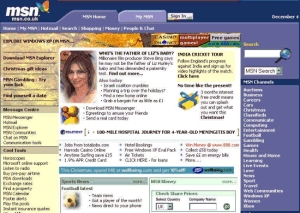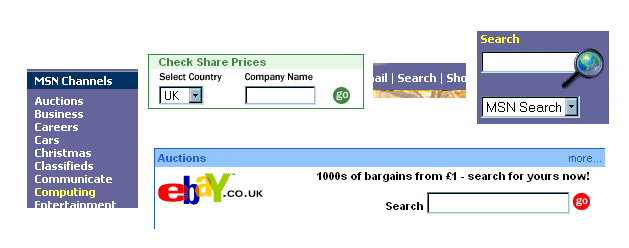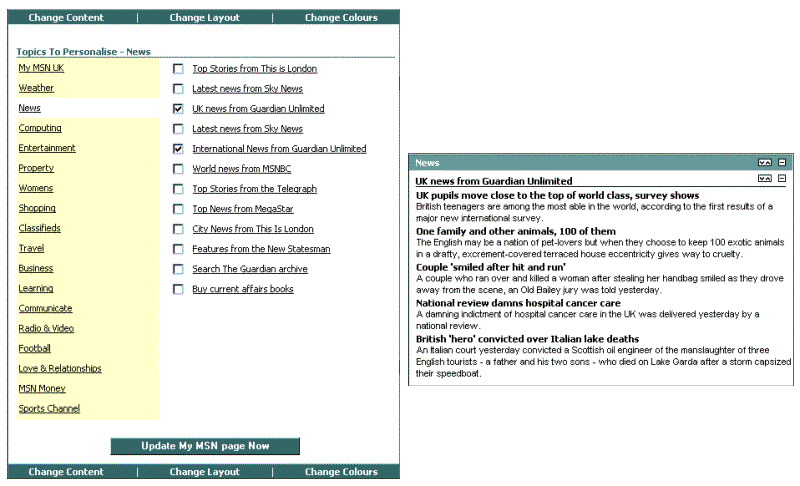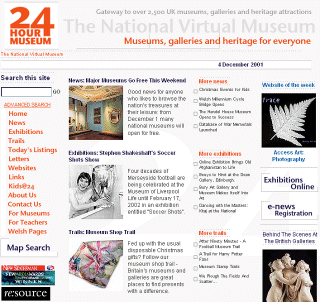The Concept of the Portal
|
|
The portal is an increasingly common sight on the Web, and an important aspect of the evolving Architecture [1] for the Distributed National Electronic Resource (DNER).
For users who connect to the Internet via a service provider such as MSN [2], their service provider's portal is likely to be the first thing to greet them on the Web, and there is a real desire that it be sufficiently 'sticky' for the user to remain nearby, making use of content in the portal, or provided by one of its' numerous partners.
It is useful to take a moment to explore some components of a portal, using the MSN home page (on 4 December 2001) as an example.

Figure 1: the MSN portal home page, as viewed on 4 December 2001 (© Microsoft and its suppliers, 2001)
According to the RDN definition of a portal, above, portals typically include resource discovery functionality. In a portal such as MSN, this is evident in a number of ways, both through a plethora of 'Search' boxes, and via their Channels of pre-classified resources.

Figure 2: Various search options on MSN (© Microsoft and its suppliers, 2001)
The "email access and online discussion fora" of the RDN definition are also well catered for in a portal such as MSN, with links out to related services such as Hotmail and MSN Messenger.
A portal such as MSN is an excellent example of the way in which content from various sources can be brought together on a single site, with users even able to personalise the information they receive to a degree. MSN — and others like it — fail, though, to manage the degree of 'deep linking' and personalisation that we might wish to see. Within the MyMSN personalisation options, for example, I can choose to receive weather forecasts for a city; but not for two. I can choose to receive UK News Headlines from the Guardian (Figure 3), but then get all of the headlines in the feed, rather than being able to select certain topics of interest. Further, the very plethora of search options (partially illustrated in Figure 2) is both a strength and a weakness; a strength as it offers users access to a wide range of material, yet a weakness as it runs the risk of overwhelming users with the number of choices, and as it demonstrates the low degree of integration between resources behind the scenes.

Figure 3: Personalising a news feed in MyMSN, and the resulting News (© Microsoft and its suppliers, 2001)
Away from the commercially-financed portals such as MSN, and closer to the world of Ariadne, the current generation of portals is somewhat different. As a rule, they concentrate far more upon resource discovery and upon gathering of information on a topic. Good examples for this type of portal are HERO and the 24 Hour Museum.
 |  |
| Figure 5: The HERO Portal (© HERO, 2001) | Figure 4: The 24 Hour Museum (© 24 Hour Museum, 2001) |
In both cases, the emphasis is upon offering a single port of call for those interested in a given topic, and in ensuring that high quality information is available to meet the needs of the user. Neither offer options for personalisation, nor give their users email and the like.
Individual institutions, too, are beginning to build portals for their users, either based around commercial portal software such as Jasmine (now called CleverPath) [3] or, increasingly, exploring the Open Source potential of uPortal [4].

Figure 5: Demonstrator for uPortal at the University of Delaware
These institutional portals seek to fulfill a range of functions, providing news feeds of interest to the institution, perhaps linking to management systems in order to track fees payments etc., and integrating to a degree with back-end databases handling timetabling, room bookings and the like in order to remind students where they need to be and when.
The missing link(s)
As well as a growing emphasis upon institutional portals, which seek to offer unified access to a range of essentially local services and resources, there is also work underway to portal-ise national offerings from organisations such as the JISC. The Resource Discovery Network (RDN), for example, is working to add access to a number of external resources [5], as well as the quality-assured resource descriptions for which they are already well known. The DNER Architecture [1], too, concerns itself with the ways in which content from different locations might be 'surfaced' through user–focussed portals, wherever they might be.
We have, then, a number of related developments, some of which certainly have the potential to compete in the near future:
- freely available commercial portals such as MSN, trying to be as sticky as possible, and providing access to a range of useful proprietary services (email, etc.) and some prescribed content (news feeds, reference material...)
- emerging institutional portals, principally focused upon providing access to local functions and services, but capable of pointing to external content
- portal-isation of nationally provided content
- Virtual Learning Environments (VLEs) and Managed Learning Environments (MLEs)
Consensus remains elusive on, amongst other things, how portals relate to VLEs, and whether the focus of community portal-building effort should be institutional or national in nature. It is also unclear whether or not portals from the educational community can really compete in any meaningful way with the likes of MSN. If they cannot, should we not simply concern ourselves with other things?
For the user, a portal is surely only useful if it meets a real need that they have, and in a way with which they are comfortable. As such, the portal needs to do more than any of the current offerings manage. To facilitate this, there is need for continued work on ensuring interoperability of systems along the lines being pursued by the DNER Architecture [1], the uPortal [4] and OKI [6] initiatives, and by JISC's MLE group [7] , to name but a few. We also need better interoperability of content, and a far better understanding of the very different things our users actually wish to do.
Some of this work has begun, but we need to move much further forward in numerous areas before we can begin to build truly useful portals.
Portals have come a long way. How much further do we need to go in order to realise a vision in which 'the Portal' becomes the flexible working environment of choice for members of our universities and colleges; offering truly integrated means of locating and interacting with both local and remote resources from email and room timetables to chat facilities, payment functionality, authenticated access to subscription–based resources, and deep links into fully customisable content from a wealth of providers? Is such a portal institutional, 'commercial', national, or some new hybrid? Is this something that people even want?
References
- The DNER Architecture. http://www.ukoln.ac.uk/distributed-systems/dner/arch/.
- MSN. http://www.msn.co.uk/.
- Jasmine/ CleverPath. http://www3.ca.com/Solutions/SubSolution.asp?ID=305.
- uPortal. http://mis105.mis.udel.edu/ja-sig/uportal/.
- RDN Subject Portals Development Project. http://www.portal.ac.uk/.
- Open Knowledge Initiative. http://web.mit.edu/oki/.
- JISC Managed Learning Environment Steering Group. http://www.jisc.ac.uk/jciel/mlesg/.
Author Details
| Paul Miller Interoperability Focus UKOLN Email: p.miller@ukoln.ac.uk |
